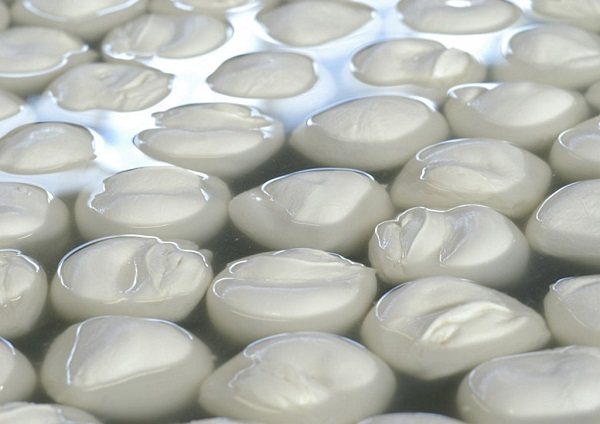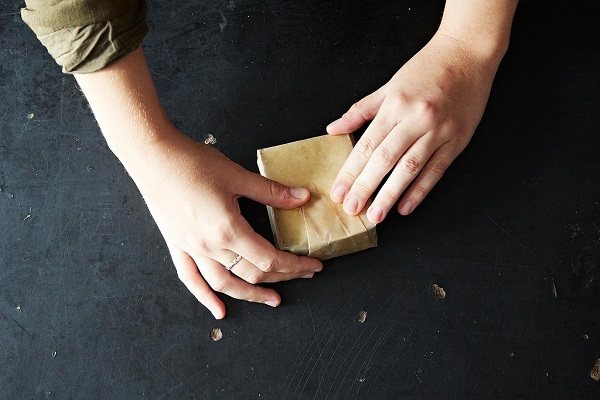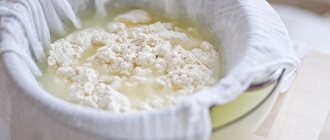How nice it is to cook truly tasty and healthy homemade products: butter, ham or cheese. But in crafting it is important not only to produce it correctly, but also to preserve the results of painstaking efforts. Today at the Craft School we are learning how to store cheese correctly. I will tell you everything you need to know about the rules and features of storing various types of cheese at home.
The bell rings - let's start the lesson!
Different types of cheese are stored differently
General rules for storing cheese
Craft cheese is distinguished by the absence of artificial preservatives, therefore, like all natural products, it has a short shelf life. Cheese does not tolerate sudden changes in storage conditions. It must be protected from moisture and dryness, open sun and temperature changes.
In a city apartment, cheese will have to be stored in the refrigerator, but the ideal place to store the product is a separate ventilated cellar with a low temperature of −4 to 0 degrees and a humidity of about 90%.
Soft, semi-hard and hard cheese in whole heads can be stored for a long time even in a household refrigerator (up to 2–4 months). The cheese is protected from drying out and spoilage by a natural crust or a wax (latex) protective coating. Today we will talk about the features of storing cheese not in whole heads, but cut into pieces.
There are several general storage rules.
- Store different types of cheese separately to prevent flavors from mixing.
- Cling film is not the best material for storing cheese. It creates conditions for high humidity and can provoke the development of pathogenic microflora, especially during long-term storage. But if you have no other options but to wrap the cheese in cellophane, then wrap the cheese with a piece of refined sugar. It will absorb excess moisture.
- The optimal temperature for storing cheese is from −2 to +6 degrees. Any home refrigerator can easily provide a temperature of 3–5 degrees; this is quite enough for storing most types.
- The larger the piece of cheese, the longer it will last.
- The main problem with a conventional household refrigerator is changes in humidity and temperature, which can damage the taste of cheese. Therefore, it is best to have a separate drawer for cheese, just like for vegetables and fruits. He'll be safer there.
- The place for cheese is in the lower section of the refrigerator. If the refrigerator has a “cellar” compartment, then store the cheese in it.
Each type of cheese has its own storage rules and features, and I will talk about them further.
Can cheese be frozen?
I do not recommend using blast freezing for homemade cheese. Only for very dense varieties with a perfectly uniform structure, and then only as a last resort. The remaining types are guaranteed to lose texture and aroma, since when frozen, microcrystals of ice are formed, which disrupt the structure of the cheese, and when defrosted, impart excess moisture to it.

These experts know exactly how and where to store cheese!
Changes during storage
During storage, the quality of cheeses changes as a result of biochemical and chemical processes occurring in rennet cheeses, the development of microorganisms on the rind and the influence of physical factors.
As a result of these changes, cheeses may acquire the following defects.
Over-ripening
Before being released for sale, rennet cheeses are kept in the basements of cheese factories at a certain temperature and relative humidity. Under these conditions, complex biochemical and chemical processes occur in cheeses, as a result of which they ripen, that is, they acquire the taste, aroma, texture and pattern characteristic of each type. Ripening occurs under the influence of enzymes introduced during the production of cheeses - rennet and pepsin, as well as those produced by microorganisms.
During the ripening process, profound changes occur in the constituent parts of cheeses, especially proteins and sugars. Fats change mainly only in cheeses ripened with the participation of molds (Roquefort, etc.).
Milk proteins break down first into albumose and peptones, then into amino acids, milk sugar into lactic acid and some other substances.
The breakdown products of the constituent parts of the cheese mass interact with each other. In this case, substances are formed that determine the specific taste and aroma of the cheese.
In insufficiently ripened cheeses; there may be such defects as unexpressed taste and aroma, bitter taste, belty consistency.
Cheeses are delivered to commercial enterprises ripened. However, under favorable conditions, biochemical and chemical processes also occur when they are stored in commercial warehouses and stores.
As a result of these processes, the quality of cheeses can improve, and defects caused by insufficient ripening of cheeses disappear. However, cheeses can become overripe due to the accumulation of excessive amounts of breakdown products of proteins and fats. Overripe cheeses are characterized by a sharp, unpleasant, sometimes rancid taste, and their consistency deteriorates.
The rate of overripening of cheeses depends on their type, storage conditions, degree of ripening before entering commercial enterprises and other factors.
All other things being equal, hard rennet cheeses are much more shelf-stable than soft ones. Within these groups, the storage stability of individual cheeses also varies. Cheeses that are best stored are: Swiss, Soviet, Altai, Moscow. Cheeses with a slimy rind. (Latvian and others) ripen faster.
As the ambient temperature rises, the speed of biochemical and chemical processes increases and the overripening of cheeses accelerates.
The best temperature for storing cheese is considered to be no higher than 8°C.
VNIHI has obtained positive results for storing well-ripened cheeses at temperatures from 0 to -5 ° C. Under these conditions, over-ripening and microbiological processes on the rind are slowed down and shrinkage is reduced.
Based on these experiments, the industry began to widely practice storing cheeses at sub-zero temperatures.
VNIIETsystems experiments on long-term storage of cheeses in refrigerators also showed that at sub-zero temperatures (down to -4°C), over-ripening is delayed, microbiological processes on the rind are slowed down, and shrinkage is reduced. However, in some batches of Swiss and Soviet cheeses at sub-zero temperatures after 4-5 months. storage, loss of milk stones was noted, whereas at above-zero temperatures (2-4°C) this defect appears later.
The inherent defects of unripe cheeses - unexpressed taste and smell, rough texture, bitterness (in Latvian and some others) - do not disappear during storage at sub-zero temperatures. During storage under these conditions, the quality of such cheeses remains unchanged or deteriorates.
At a positive temperature, the noted defects, as a rule, disappear after 1-2 months. storage Therefore, only well-ripened cheeses can be stored at subzero temperatures (down to -4°C).
Unclean taste
This defect is a consequence of the development of gas-forming and putrefactive microflora. It appears more often in cheeses made from unpasteurized milk.
Musty, rotten and putrid taste
These taste defects arise due to the same reasons as unclean taste, but with a stronger development of gas-forming and putrefactive microflora.
Greasy taste
Appears as a result of the development of butyric acid bacteria. During long-term storage, cheese may acquire a greasy taste due to fat oxidation.
Rancid taste
It is formed during long-term storage of cheeses as a result of the accumulation of fat breakdown products in them.
In soft cheeses ripened with the participation of molds (Roquefort cheeses, etc.), some breakdown of fat is normal, since the breakdown products cause the appearance of a pungent taste specific to these cheeses. In hard cheeses, even as a result of a slight breakdown of fat, defects in taste and smell arise. Therefore, hard cheeses should be stored in conditions that prevent them from overripening, and also prevent the development of molds on the surface, which also cause the decomposition of fat.
Bitter taste
Appears in cheeses ripened at lower temperatures than required. In this case, due to the slow development of microorganisms, the processes of protein breakdown by microorganisms lag behind its breakdown by enzymes - rennet and pepsin; At the same time, protein breakdown products—peptones and albumoses—accumulate.
When storing cheeses at elevated temperatures, this defect may disappear. A bitter taste can also be present in cheese of feed origin, or as a result of the use of table salt with an admixture of magnesium and sodium sulfate for salting it, or as a result of the development of microorganisms in cheeses that secrete rennet.
Ammonia taste and smell
In cheeses with a hard rind they appear due to the development of alkali-forming bacteria, which can mainly be due to the appearance of mucus on the rind. For cheeses with a slimy rind, ammonia taste and smell are specific.
Blistering
It occurs due to the development of gas-forming bacteria in cheeses. Gases - hydrogen and others - released by these bacteria cause the cheese dough to swell, forming cracks and tears in the crust. Swelling is accompanied by the appearance of greasy and other foreign tastes.
In commercial enterprises, this defect is especially often observed in soft cheeses stored in a warm place.
Loss of milk stone
Milkstone is calcium propionate, which precipitates in the raw dough in the form of white dots; When chewing the cheese, a slight crunch is felt.
Loss of milkstone is most often observed in Swiss and Soviet cheeses. In cheeses stored at sub-zero temperatures, this defect forms faster than at positive temperatures.
Milk stone appears as a result of the excessive content of calcium salts in cheeses, which are added to milk to increase its ability to coagulate under the influence of rennet.
Development of microbiological processes on the crust
Various types of molds, putrefactive bacteria and yeasts can develop on the surface of rind cheeses. These microorganisms use protein and partly the fat of the product for their vital functions.
Molds develop on the crust as patches of grey, green, yellow or brown. They often appear in places where cheese samples are taken with a probe, in cracks and voids communicating with the outside air.
A particular danger is posed by smallpox mold, which destroys not only the rind, but also the subcortical layer of cheese. At first, barely noticeable velvety white dots appear on the rind, which gradually grow, deepen into the subcortical layer and form small-scale formations of gray or cream color on the surface of the cheese.
The development of mold not only worsens the appearance of the cheese, but also gives it a musty taste and smell.
Mold is removed by wiping the surface with clean calico soaked in a solution of table salt. Cheeses affected by smallpox mold, as well as mold in the subcortical layer, are unsuitable for storage. They are immediately implemented, having previously cleaned the affected areas.
Yeast develops in cheese and forms pink spots.
The development of putrefactive bacteria is characterized by the appearance of white spots, which gradually grow and merge together. The breakdown products of proteins and fats, formed as a result of the vital activity of microorganisms, worsen the taste and smell of cheeses.
The crust in the affected areas becomes loose and acquires a putrid odor, which can be transferred to the cheese. This defect is called crust cancer. Cheese affected by cancer must be sold immediately, having cleared the affected areas before sale.
Microorganisms can only develop if there is a certain amount of moisture. Therefore, cheeses with a soft, moist rind are more susceptible to spoilage than those with a dry rind.
The paraffin coating, if it does not have cracks, protects the crust well from microorganisms, the condition of which depends on the relative humidity of the air. In dry rooms, the surface of the cheese dries out, which prevents the development of microorganisms. The occurrence of mold is delayed even when the relative humidity is below 82%.
Air circulation is also important. In a room with stagnant air around the product, areas of high humidity are created, which promotes the development of microorganisms on the surface of the cheese. The vital activity of microorganisms also depends on the ambient temperature. Therefore, storing cheeses in cooled and well-ventilated areas is an effective means of preventing mold and rotting.
Rustless cheeses in a polymer film are sometimes contaminated with mold and yeast spores, which, during storage, begin to intensively develop on the surface of the heads under the film, in places where it is damaged or does not adhere tightly to the surface of the cheese.
Shedding of paraffin
Appears when the recipe or waxing technology is not followed, as well as due to shocks and shaking of the cheese during stacking and transportation. The rind of a cheese with a damaged paraffin layer is more easily susceptible to mold and rotting, and the shrinkage of the cheese increases.
Blue in the face
This defect is typical for brine cheeses. Gray or black spots appear on their surface, sometimes with greenish or bluish tints, which spread deeper. The cheese takes on a distinctly unclean or too pungent taste. Blue discoloration occurs due to contamination of cheese or brine with salts of iron, lead, copper and some other metals. Blue discoloration stops at low storage temperatures and the use of acidic brine (pH 5).
Deformation
Cheeses during storage can become deformed under the influence of their own gravity, in most cases due to improper and careless stacking. Soft cheeses are especially easily deformed when stored in warm and damp warehouses.
Cracks in the crust
At low relative humidity or in a draft, soft cheeses dry out and their rind cracks. This happens less frequently with hard-rind cheeses. Excessive loss of moisture makes the consistency of the cheese hard and rough.
Warming the crust
Occurs when cheeses are rarely turned over during storage; the softened crust that has become softened rots easily.
Freezing
The freezing temperature of cheeses lies within the following limits: Soviet and Cheddar from -9.0 to -9.7 ° C, Swiss from -6.8 to -7.3; Dutch, Poshekhonsky, Kostromsky, Russian, Estonian and Yaroslavsky from -6.0 to -6.7, low-fat cheeses from -4.8 to -7.4, soft cheeses from -2.3 to -6, processed cheeses from - 3.9 to -6.4 °C.
Freezing significantly reduces the quality of rennet cheese. The water in the cheese forms needle-like crystals that permeate the entire mass of the product. After thawing, it cannot be completely absorbed by the cheese mass and, when cut, flows out in the form of cheese juice; the consistency of the cheese becomes crumbly, the specific taste weakens, paraffin easily detaches from the crust and crumbles. Thawing methods do not have a noticeable effect on the quality of the cheese, although slow thawing produces slightly better results than fast thawing.
As for processed cheeses, as ZIST research and the practice of some refrigerators have shown, their quality does not change noticeably when frozen. Therefore, in refrigerators, especially in areas of early delivery of goods, some processed cheeses (group I - Yantar and Chocolate) are sometimes frozen at a temperature of - 18 ° C and stored at the same temperature, and when released for sale they are defrosted, kept at a temperature of 0...4 °C.
Processed cheese foil corrosion
Caused by the action of alkaline chemicals added during the production of processed cheeses and weak organic acids contained in the cheese. At first, light spots appear, which then darken. Tin foil is less susceptible to corrosion than aluminum foil. To protect against corrosion, the foil is coated with a layer of special food varnish. Storing processed cheeses in dry warehouses delays the development of corrosion.
Shrinkage
Cheeses contain from 35 to 55% moisture. It has been established that 20-25% of this moisture is associated with protein substances and it can be removed from cheese only by breaking the connection between water and protein. The rest of the moisture is in a free state, and its movement is determined by the laws of diffusion.
Cheeses that contain more moisture, other things being equal, dry out more.
Covering their surface with paraffin or a paraffin-polymer alloy reduces the shrinkage of cheeses by at least 3-5 times.
An even better effect is achieved by packaging cheeses in polymer films. The weight of these cheeses changes slightly during storage.
As the temperature decreases and the relative humidity of the surrounding air increases (within acceptable limits), the shrinkage of cheeses decreases noticeably.
The drying of cheeses stored in air-cooled chambers increases by approximately 40% compared to drying in radiator-cooled chambers. Cheeses stored on racks usually lose more moisture than in containers.
The weight of brine cheeses when stored in brine, as a rule, increases due to the swelling of proteins.
Cheeses are damaged by mites, fly larvae, mice and rats.
Mites loosen the cheese with their jaws. Mite-infested cheeses are usually covered with a gray powder consisting of dead mites, testicles, excrement and shed skins.
Flies lay eggs in cracks and folds of the crust, from which larvae form. Mice and rats chew holes in the rind and eat away the cheese dough, usually damaging the best quality cheeses. Therefore, it is necessary to take measures to combat barn pests.
How to store fresh cheeses
Fresh spreadable cheeses are mascarpone, ricotta, mozzarella, Philadelphia and other soft cheeses. They are easiest to prepare at home; you don’t even need a cheese press.
They are stored for 3 to 5 days. The easiest way is to put fresh cheese in a glass jar with a tight lid. During storage, the cheese will likely release some liquid. There is no need to drain it, it moisturizes the cheese and preserves its delicate texture. Place the jar on the bottom shelf and make sure it is sealed. Fresh cheese instantly absorbs all odors.
The storage temperature for spreadable cheeses is no higher than 5 degrees Celsius; it is best to keep them at a temperature of 0 to 3 degrees.

Store fresh cheeses in a glass jar with a tightly sealed lid.
Is it possible to freeze mascarpone?
Mascarpone is an Italian cream cheese. It was first started between the towns of Lodi and Abbiategrasso at the end of the 16th century. Currently, the product is popular in all countries. Its soft consistency allows the cheese to be used for preparing:
- creams;
- desserts;
- sandwiches;
- various types of snacks.
The delicacy is often used as a filler for tartlets with caviar and red fish. Some experts compare it to butter. It is just as fatty, but the taste is softer and creamier.
Lactic acid bacteria are not used in the production of mascarpone, so some experts believe that calling it cheese is only conditionally permissible. To make such a delicacy, the cream is heated and lemon juice or wine vinegar is added. This leads to coagulation of milk protein and separation of whey. Afterwards the product is cooled, pressed and other manipulations are carried out to remove whey.
Mascarpone can be stored for no more than 4 hours. This is the standard period for a delicacy prepared at home. Industrially produced cheese contains preservatives, so it can be stored for up to 4-5 months. Information about the production date and expiration dates is on each package. It should be borne in mind that after opening the jar, the period of safe storage is no more than 48 hours.
Such a limited period makes you think about freezing the product. This could solve a lot of problems. But mascarpone cannot be frozen. After defrosting, its consistency changes and its appearance is lost. Storing in the freezer causes whey to separate. When the delicacy thaws, a large amount of water is released from it. It becomes impossible to beat it.
Less liquid will be released after thawing if cheese is frozen in modern freezers at a temperature of -25 °C. But this does not guarantee that it can subsequently be used for its intended purpose.
If the expiration date is coming to an end or the jar is in the refrigerator and something urgently needs to be done with it, you can prepare a cream with the addition of mascarpone and then place it in the freezer. Thawed cream is not as tasty and fluffy as fresh cream, but it can be used for making desserts. Some housewives immediately make tiramisu with mascarpone and store it in the freezer, and then use it as needed.
Mascarpone is very popular among housewives. Without it, it is impossible to prepare some types of creams and popular desserts. The product is quite expensive and has a limited shelf life, so questions regarding its storage often arise.
How to store pickled cheeses
Brine cheeses are prepared in salt brine. The most famous are mozzarella, suluguni, feta cheese. They have different shelf life.
- Mozzarella can be stored for 3 to 5 days, just like fresh cheeses.
- Cheese cheese can be stored for up to 2 months in the refrigerator.
- Suluguni – up to 3 weeks.
Their storage temperature should not exceed 8 degrees.
It is best to store brined cheeses in salt brine. Its salinity should be from 16 to 18%.
Pickled cheeses are stored in enamel containers or in the same wooden barrels or kegs in which the pickling took place. The brine needs to be changed to fresh one every two to three weeks, this will extend the shelf life of the cheese.

Mozzarella and other brine cheeses are stored in brine
What determines the shelf life?
Cheese is a product of milk processing and is therefore considered a perishable product. It can rightfully be called “living” product.
Even after the cheese is made and packaged, the ripening process continues.
However, sooner or later it will develop into a process of rotting , or the cheese will simply dry out and become moldy.
The shelf life of different cheeses depends on several factors :
- varieties - different types of cheeses have different shelf life;
- technical production conditions and their compliance by the manufacturer - even the same variety can be produced using different methods;
- compliance with storage and transportation conditions - only when all the rules are followed, the expiration date declared by the manufacturer is valid.
The following article contains information about the shelf life and storage conditions of kefir.
How to store soft cheeses
Soft cheeses include Camembert, Brie, and Limburg cheese. They usually have a soft crust, and in some varieties it has a moldy crust. For long-term storage, whole, uncut soft cheeses are left in the same forms in which they matured.
To store in the refrigerator, such cheeses are wrapped in special cheese paper and placed in a ceramic or glass container larger in volume than the portion of the product. This is necessary in order to ensure that the desired level of humidity is maintained.
Modern refrigerators have good ventilation systems to combat odors, but multi-channel ventilation reduces air humidity, which is harmful to cheese. A large container provides the cheese with a more stable microclimate than a cramped piece-sized package.
You can use parchment or wax paper instead of cheese paper.
There is another way - wrap the cheese in several layers of gauze and place it in an enamel bowl with a lid. The lid should not be airtight so that natural ventilation does not stop.
During storage, turn cheese with a white and washed rind twice a week. These cheeses may still be undergoing the ripening process, and turning them over will help ensure that the ripening process occurs evenly.
In the refrigerator at a temperature of 3–5 degrees, freshly prepared soft cheese with a white or washed rind can be stored for up to 4 weeks.

Soft cheeses with rind are stored in gauze or paper
Shelf life and storage conditions of various varieties
Depending on the density and preparation technology, different types of cheeses are classified. The difference lies in the taste and conditions required for each variety.
- Soft. The consistency is creamy, soft or curd-like. This type is not subject to additional processing. There are types with a crust. For soft fresh varieties, a temperature of 0-8 C is suitable. If the product is moldy, 0-6 C. Air humidity should be 70-85%. They are stored for about 5 days after release. Varieties in brine prefer temperatures up to 8C. Can be stored from a month to 2.5-3 months.
- Semi-solid. The consistency is also creamy, but dense. The ripening period and pressing technology distinguish these varieties from soft ones. The conditions are the same as for durum varieties.
- Solid. Cannot be cut. They are used mainly grated. Or served in pieces. Such cheeses are stored from a month to a year, at -4 - 0 C. The recommended air humidity is in the range of 85-90%.
- Smoked. The density is close to solid. The difference lies in the method of preparation and the taste of the final product. Film packaging will help preserve it for up to 4 months. Paraffin for about 2 months. The packaging must be dry. The presence of moisture indicates improper storage. The color of the product must be uniform. Storage temperature 2-6 C.
- Fused. Refers to a cheese product. Since the composition often includes vegetable fats. Quite unpretentious. Can be stored for about a year. The storage place should be dry, with good ventilation. Air humidity is no more than 90% and no less than 85%. Temperature -4 - 0 C.
Storing hard cheeses
The name speaks for itself. Hard cheeses have a dense body that breaks easily. Examples of hard cheeses: Parmesan, cheddar, Kostroma, Swiss.
They are stored wrapped on the cut side with natural cloth, slightly moistened in lightly salted brine. The cheese is wrapped in foil or wax paper over the fabric. The cheese is then placed in a glass or ceramic container, which is placed on the bottom shelves of the refrigerator.
You can also use a lightweight storage option: wrap the cheese in a regular paper napkin and put it in a container. Each time after using cheese, the napkin must be changed and the container wiped dry.
A compromise packaging option could be a glass or enamel bowl covered with foil or a thick linen napkin. Place the cheese in it in parchment or cloth.
Hard cheeses are stored at temperatures from 0 to 5 degrees. If all requirements are met, this product will easily withstand storage for 4-5 weeks.

Hard cheeses are wrapped in parchment, cloth or wax paper for storage.
Storing semi-hard cheeses
Examples of semi-hard cheeses: Gouda, Colby, aged cachota. They are best wrapped in parchment or wax paper and placed in a container. A glass or ceramic mold is suitable; you can use a cheese pan with a glass domed lid. The container should not be sealed hermetically, otherwise the natural processes that continue in cheeses, especially homemade ones, are disrupted.
Store semi-hard cheeses at temperatures from +2 to +6 degrees for 2–3 weeks. If you can maintain the temperature at 0–1 degrees, then the period can be increased to 4 weeks.
Storing blue cheeses
These types of cheeses owe their mold veins to special fungi. In the refrigerator, these cultures will readily try to spread to other dairy products, so blue cheese should be packaged with special care. Roquefort, Gorgonzola and Dor Blue are stored in tightly closed containers, first wrapped in parchment. Glass jars with tightly sealed, airtight lids or containers are suitable for storage.
Every 2-3 days the cheese should be allowed to breathe. To do this, take it out, unwrap it and place it on a plate, leave it in the refrigerator for 30–40 minutes, then wrap it again in fresh parchment and put it in a container.
Blue cheeses cannot be stored for long. They require a storage temperature of −4 to +2 degrees and are stored for up to 3 weeks.

Blue cheeses are stored in tightly closed containers, periodically allowing the cheese to “breathe”










